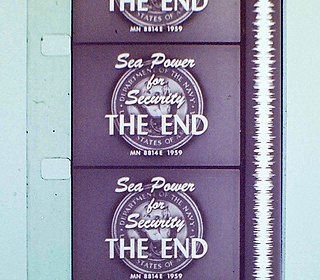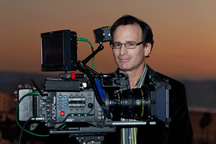
Film editing is both a creative and a technical part of the post-production process of filmmaking. The term is derived from the traditional process of working with film which increasingly involves the use of digital technology.

16 mm film is a historically popular and economical gauge of film. 16 mm refers to the width of the film; other common film gauges include 8 and 35 mm. It is generally used for non-theatrical film-making, or for low-budget motion pictures. It also existed as a popular amateur or home movie-making format for several decades, alongside 8 mm film and later Super 8 film. Eastman Kodak released the first 16 mm "outfit" in 1923, consisting of a camera, projector, tripod, screen and splicer, for US$335. RCA-Victor introduced a 16 mm sound movie projector in 1932, and developed an optical sound-on-film 16 mm camera, released in 1935.

L.A. Confidential is a 1997 American neo-noir crime film directed, produced and co-written by Curtis Hanson. The screenplay by Hanson and Brian Helgeland is based on James Ellroy's 1990 novel of the same name, the third book in his L.A. Quartet series. The film tells the story of a group of LAPD officers in 1953, and the intersection of police corruption and Hollywood celebrity. The title refers to the 1950s scandal magazine Confidential, portrayed in the film as Hush-Hush.

Post-production is part of the process of filmmaking, video production, audio production, and photography. Post-production includes all stages of production occurring after shooting or recording individual program segments.

In film and television production, B-roll, B roll, B-reel or B reel is supplemental or alternative footage intercut with the main shot. The term A-roll referring to the main footage has fallen out of use.

Republic Pictures Corporation was an American motion picture production-distribution corporation in operation from 1935 to 1967, that was based in Los Angeles. It had studio facilities in Studio City and a movie ranch in Encino. It was best known for specializing in Westerns, serials, and B films emphasizing mystery and action. Republic was also notable for developing the careers of John Wayne, Gene Autry, and Roy Rogers. It was also responsible for the financing and distribution of a few A films directed by John Ford during the 1940s and early 1950s and one Shakespeare film, Macbeth (1948), directed by Orson Welles. Under Herbert J. Yates, Republic was considered a mini-major film studio.

Pink Floyd: Live at Pompeii is a 1972 concert documentary film directed by Adrian Maben and featuring the English rock group Pink Floyd performing at the ancient Roman amphitheatre in Pompeii, Italy. Although the band perform a typical live set from the era, there is no audience beyond the basic film crew. The main footage in and around the amphitheatre was filmed over four days in October 1971, using the band's regular touring equipment, including a mobile 8-track recorder from Paris. Additional footage filmed in a Paris television studio the following December was added for the original 1972 release. The film was then re-released in 1974 with additional studio material of the band working on The Dark Side of the Moon, and interviews at Abbey Road Studios.

Sony Pictures Entertainment Inc. is an American entertainment company that produces, acquires, and distributes filmed entertainment through multiple platforms. Through an intermediate holding company called Sony Film Holding Inc., it is operated as a subsidiary of Sony Entertainment Inc., which is itself a subsidiary of the multinational technology and media conglomerate Sony Group Corporation. Based at the Sony Pictures Studios lot in Culver City, California, it encompasses Sony's motion picture, television production and distribution units. Its group sales in the fiscal year 2017 has been reported to be $9.133 billion.
Stock footage, and similarly, archive footage, library pictures, and file footage is film or video footage that can be used again in other films. Stock footage is beneficial to filmmakers as it saves shooting new material. A single piece of stock footage is called a "stock shot" or a "library shot". Stock footage may have appeared in previous productions but may also be outtakes or footage shot for previous productions and not used. Examples of stock footage that might be utilized are moving images of cities and landmarks, wildlife in their natural environments, and historical footage. Suppliers of stock footage may be either rights managed or royalty-free. Many websites offer direct downloads of clips in various formats.
The Biograph Company, also known as the American Mutoscope and Biograph Company, was a motion picture company founded in 1895 and active until 1916. It was the first company in the United States devoted entirely to film production and exhibition, and for two decades was one of the most prolific, releasing over 3000 short films and 12 feature films. During the height of silent film as a medium, Biograph was America's most prominent film studio and one of the most respected and influential studios worldwide, only rivaled by Germany's UFA, Sweden's Svensk Filmindustri and France's Pathé. The company was home to pioneering director D. W. Griffith and such actors as Mary Pickford, Lillian Gish, and Lionel Barrymore.

Ben-Hur is a 1959 American religious epic film directed by William Wyler, produced by Sam Zimbalist, and starring Charlton Heston as the title character. A remake of the 1925 silent film with a similar title, it was adapted from Lew Wallace's 1880 novel Ben-Hur: A Tale of the Christ. The screenplay is credited to Karl Tunberg, but includes contributions from Maxwell Anderson, S. N. Behrman, Gore Vidal, and Christopher Fry.

In filmmaking and video production, footage is raw, unedited material as originally filmed by a movie camera or recorded by a video camera, which typically must be edited to create a motion picture, video clip, television show or similar completed work.

A lost film is a feature or short film that is no longer known to exist in any studio archives, private collections, or public archives, such as the U.S. Library of Congress.

Associated Artists Productions, Inc. (a.a.p.) was a distributor of theatrical feature films and short subjects for television. Through acquisitions, Associated Artists Productions' assets were purchased by United Artists, with its library eventually passing to Metro-Goldwyn-Mayer in 1981, following its purchase of United Artists, and then to Turner Entertainment Co., following its purchase of the pre-1986 assets of Metro-Goldwyn-Mayer and select United Artists assets. Turner Entertainment is now part of WarnerMedia. Though a short lived company, Associated Artists Productions lived a legacy of being best known as the copyright owner of the Popeye, and the color pre-1948 Looney Tunes and Merrie Melodies series of shorts by Paramount Pictures and Warner Bros. respectively, as their logos and trademarks were present at the beginning of each short's 16mm Eastmancolor prints syndicated for television in the 1960s.

Plan 9 from Outer Space is a 1957 independently made American black-and-white science fiction-horror film, produced, written, directed, and edited by Ed Wood. The film was shot in November of 1956, and had a theatrical preview screening on March 15, 1957 at the Carlton Theatre in Los Angeles. It later went into general release on July 22, 1959 re-titled Plan 9 from Outer Space.

Koyaanisqatsi, also known as Koyaanisqatsi: Life Out of Balance, is a 1982 American experimental film produced and directed by Godfrey Reggio with music composed by Philip Glass and cinematography by Ron Fricke.

Technicolor is a series of color motion picture processes, the first version dating to 1916, and followed by improved versions over several decades.
FOCAL International is the trade association representing stock footage companies, post-production facilities and individuals involved in the use of footage, still images and audio in all forms of media production. It represents more than 300 companies and individuals involved in media production, asset management, preservation of historical archives, film restoration and post-production.
The Brain Leeches is a 1978 American low-budget science fiction exploitation film directed by Fred Olen Ray and starring Paul Jones, Marcia Scott, and Ray Starr. It has a running time of 55 minutes, and was completed on a budget of $298.00. The film was shown publicly only once, although it has since become available through distributors. The project proved to be a turning point in the careers of two of the principals.
Walter Futter was a film producer and director in the United States. After an initial career cutting and editing films, Futter began writing and producing his own shorts and movies, often using footage he acquired. He had success with Africa Speaks!, a popular movie, which combined Paul L. Hoefler's footage filmed in the field, staged scenes filmed in Los Angeles, and narration by Lowell Thomas. He produced more than 250 short films, including series of shorts entitled Walter Futter's Traveloques and Walter Futter's Curiosities. Hoot Gibson starred in a number of his western films. Another of his more than 50 longer films was Jericho, also called Dark Sands.














